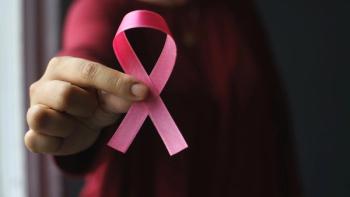
Continuing Novel Therapeutic Research Presents New Options in Lung Cancer
Key Takeaways
- Earlier-stage lung cancer diagnoses are increasing due to improved screening, shifting treatment needs towards localized, low-toxicity interventions.
- The PACIFIC trial demonstrated significant survival benefits of immunotherapy post-radiation in stage 3 lung cancer, surpassing resectable stage 2 outcomes.
Dr. Jared Weiss details the importance of continued research into novel therapies for patients with lung cancer.
The treatment of lung cancer is evolving as patients are continuing to be diagnosed at earlier stages, according to Dr. Jared Weiss, section chief of Thoracic and Head/Neck Oncology at the UNC Lineberger Comprehensive Cancer Center, located in Chapel Hill, North Carolina.
“The impact of immunotherapy was so massive that for the time between the approval of Imfinzi [durvalumab] following the PACIFIC trial, having immunotherapy after radiation in stage 3 disease actually led to a better survival expectation than having resectable stage 2 disease,” Weiss explained when sharing some of the most significant advances in the treatment of stage 3 lung cancer.
However, he goes on to cite that despite improvements, outcomes within this patient population can continue to be improved. Novel agents like JNJ-1900 may address this unmet need by stimulating antitumor immunity when combined with hypofractionated radiation. To further discuss this topic, Weiss
Weiss also serves as a professor of Medicine in the Department of Medicine, Division of Oncology, at the UNC School of Medicine.
CURE: Lung cancer remains the leading cause of cancer-related mortality globally, yet more patients are now being diagnosed at earlier stages. How does this shift influence the therapeutic landscape, particularly the need for localized, low-toxicity interventions like intratumoral therapies?
Weiss: The National Lung Screening Trial, along with other data, demonstrated that we can reduce lung cancer mortality in high-risk individuals through annual screening CAT scans. This represented a major paradigm shift in my field and largely explains why we are now diagnosing lung cancer at earlier stages. The only thing better than treating cancer at an earlier stage is preventing it, and this is as close as I believe we can get.
Smoking cessation is best, though it's important to remember that not all lung cancer is smoking-related. Beyond smoking cessation, we have the screening of those who have smoked. However, if you look both nationally and globally, the uptake of this screening is grossly inadequate. We are seeing some stage shift, but we need to see much more. A lot of unnecessary suffering and death from lung cancer could be prevented.
Nonetheless, those rates are improving, and your question is why. It's because we're going to see more earlier-stage cancer, particularly a shift from more stage 4 disease to more Stage 3 disease. When we pause and reflect on these curable but very locally advanced patients, we have to recognize that they are very hard to cure; we are currently curing only a minority of them.
Can you walk us through the most significant advances in the treatment of stage 3 lung cancer, particularly with regard to the evolving role of immunotherapy?
We have had advances. The most dramatic in recent years was the PACIFIC trial. This trial randomized patients who were supposedly surgically unresectable (and I'll come back to that "supposedly") to either chemoradiotherapy, the then-standard of care, or chemoradiotherapy followed by a year of Imfinzi. There was a dramatic improvement in cure and survival. In fact, the impact of immunotherapy was so massive that for the time between the approval of Imfinzi following PACIFIC, having immunotherapy after radiation in stage 3 disease actually led to a better survival expectation than having resectable stage 2 disease.
Happily, in the year 2025, that is no longer true, because we now have perioperative immunotherapy. For the node-positive patient, the patient with a primary tumor greater than 4 centimeters who is going to undergo surgery, even the Stage III patient who is operable, they can now receive neoadjuvant, adjuvant, or both immunotherapies. Stated more simply, they can receive immunotherapy before, after, or both their surgery, and gain that advantage.
If you look at what has happened in trials since immunotherapy has become available for surgically resectable stages, what you see is that in the unresectable trials that came later, the control arms are doing a whole lot worse than PACIFIC. The reason for this is that these are truly unresectable patients, not individuals being called unresectable simply to get them into an immunotherapy trial. That's a little long-winded, but the core comment is that we're not doing that well for stage 3 disease.
Therefore, we need approaches that do better, ideally without adding much to toxicity, and JNJ-1900 is one such promising idea.
You are an investigator in a phase 1 trial evaluating JNJ-1900. Can you describe the rationale behind using JNJ-1900 as a radioenhancer in lung cancer treatment, and how it differs mechanistically from conventional radiosensitizers?
Traditional radiation for lung cancer is given in two main contexts: either you have a spot that's a particular problem, and you're giving the radiation to palliate, or you're giving it for unresectable disease with a goal of cure. In the former situation, a classic example might be a painful bony metastasis where the goal of the radiation isn't to cure the person or even extend survival, but rather to relieve pain at that site.
Another example might be a patient experiencing cough or trouble breathing due to compression of a central airway, where the goal is purely palliative: to open that airway for comfort. [In contrast], with unresectable stage three disease, [the aim] is to cure the patient.
JNJ-1900 is designed to work with hypofractionated radiation. To translate that into plainer English, when you give curative-intent radiation to a big area in the chest, it's administered over seven weeks. The total dose is broken up over six-plus weeks for safety, which is known as traditional fractionation. There's a newer form of radiation, sometimes referred to by brand names like CyberKnife, or more broadly as stereotactic body radiotherapy (SBRT) or hypofractionated radiation.
Whatever you want to call it, this is the type of radiation that JNJ-1900 is intended to work with, when you deliver a burst of radiation to a very small, focal area in one or a very small number of sessions. Therefore, you wouldn't use JNJ-1900 to treat a huge central tumor mass; you would treat a much smaller area.
Thus far, much of the data on JNJ-1900 are really centered around its use more as an immune-stimulating agent than as a traditional radiation sensitizer like chemotherapy. While it is inherently a very potent radiation sensitizer — meaning the area you deliver a small dose of hypofractionated radiation will be intensely affected — what's truly special about JNJ-1900 isn't just its radiation sensitization, but the downstream effects of that sensitization for immune stimulation.
Transcript has been edited for clarity and conciseness.
For more news on cancer updates, research and education,




